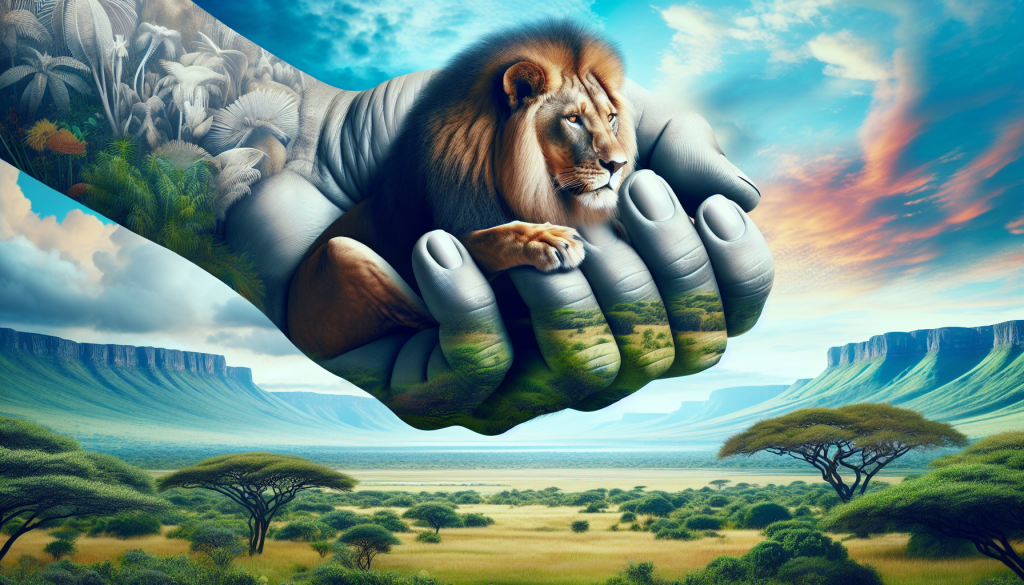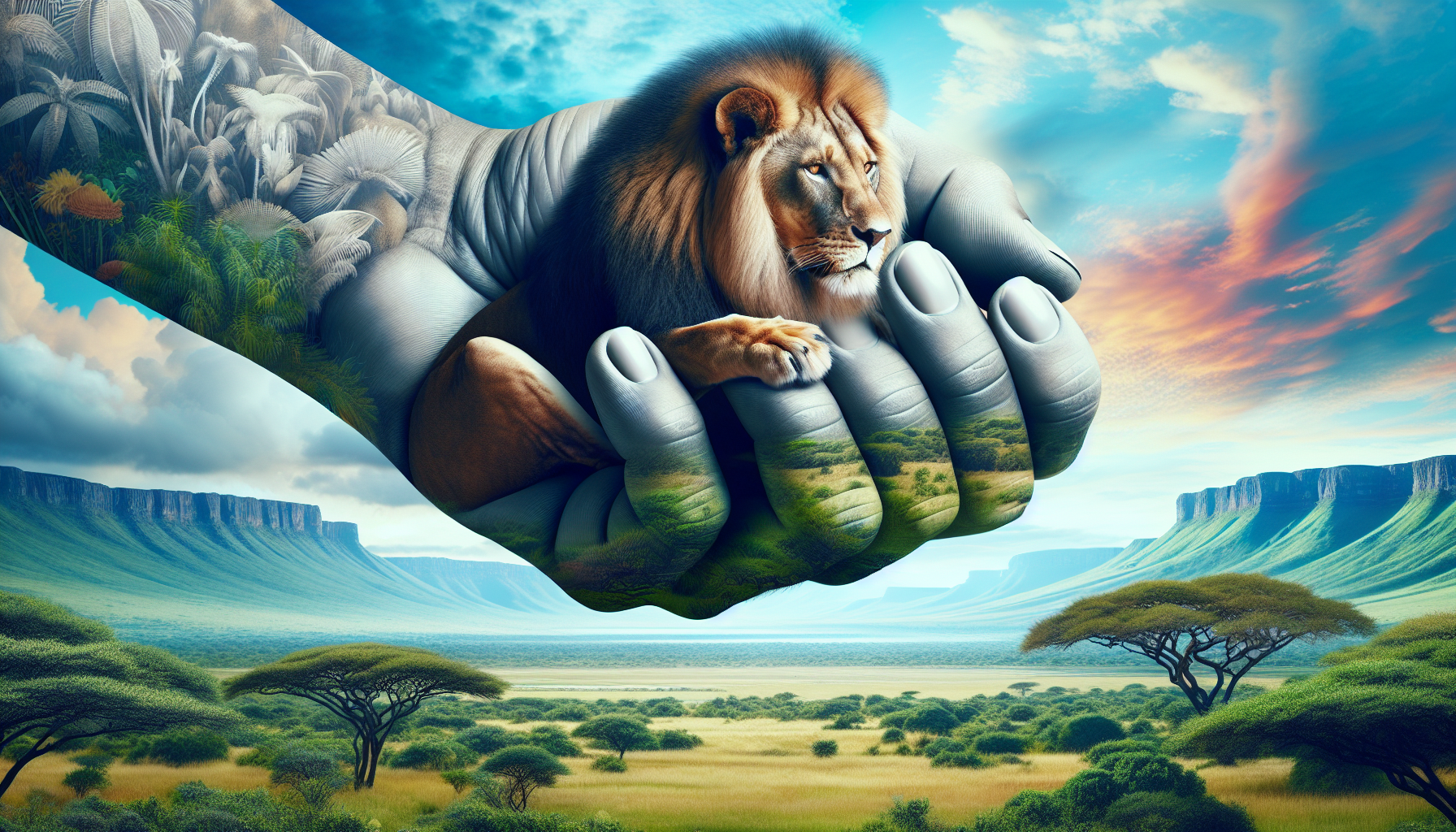So you’ve always had a fascination with lions, learning all there is to know about these majestic creatures. Well, get ready to be captivated by the fascinating world of lion conservation efforts, as seen through the lens of an encyclopedia. In this article, we’ll explore the various approaches, initiatives, and challenges faced by organizations dedicated to protecting the future of lions in their natural habitats. From community-based conservation projects to legal frameworks, get ready to immerse yourself in the world of lion conservation and gain a deeper understanding of how these efforts play a vital role in safeguarding these iconic animals for future generations.

Overview of Lion Conservation Efforts
The decline of lion populations
Lion populations across the globe have been declining at an alarming rate in recent years. Once widely distributed throughout Africa, Asia, and even parts of Europe, their numbers have significantly dwindled. The International Union for Conservation of Nature (IUCN) now classifies lions as a vulnerable species, with their populations estimated to be less than 23,000 individuals in the wild. This decline is primarily driven by habitat loss, human-wildlife conflict, poaching, and trophy hunting.
Importance of lion conservation
Lion conservation is of utmost importance due to the significant ecological role lions play in their respective habitats. As apex predators, they help regulate prey populations, maintaining a balance in the ecosystem. Furthermore, lions act as flagship species, attracting tourists and generating revenue for local communities through wildlife tourism. Conserving lions also contributes to the preservation of their habitats and the overall biodiversity of the areas they inhabit.
Historical perspective on lion conservation efforts
Efforts to conserve lions can be traced back to ancient times when lions were revered and protected by various civilizations. In more recent history, the rise of colonialism and sport hunting significantly impacted lion populations. Conservation efforts gained momentum in the 20th century with the establishment of protected areas and the recognition of the need for national and international cooperation. Despite the challenges faced along the way, these initiatives have helped to raise awareness about the importance of lion conservation and laid the groundwork for future interventions.
Habitat Preservation
Importance of preserving lion habitats
Preserving lion habitats is crucial for their long-term survival. Lions require vast expanses of land to hunt, breed, and roam freely. By conserving natural habitats, we ensure the availability of key resources such as prey, water, and shelter. Maintaining intact ecosystems also benefits other wildlife species that share the same habitats as lions, contributing to overall biodiversity conservation.
Protected areas and wildlife sanctuaries
Protected areas and wildlife sanctuaries play a crucial role in safeguarding lion habitats. These areas are designated to conserve natural ecosystems and provide a safe haven for wildlife, including lions. National parks, game reserves, and private conservancies contribute to creating a network of protected areas that ensure the preservation of lion populations and their habitats.
The role of national parks in lion conservation
National parks serve as essential strongholds for lion conservation. They provide large, uninterrupted tracts of land where lions can thrive without significant human interference. National parks often implement strict regulations and employ a range of management practices to minimize threats and maintain healthy lion populations. These areas also offer opportunities for tourists to observe lions in their natural habitats, promoting appreciation for their conservation and generating revenue for further initiatives.
Anti-Poaching Measures
The devastating impact of poaching on lion populations
Poaching poses a severe threat to lion populations, primarily driven by the illicit trade in lion parts. Lion bones, skins, and other body parts are in high demand for their use in traditional medicines, cultural customs, and even as trophies. The illegal killing of lions not only reduces their numbers but also disrupts social structures within prides, leading to potential population decline, genetic bottlenecks, and even local extinctions.
Efforts to combat poaching
Various initiatives have been implemented to combat poaching and disrupt the illegal wildlife trade that targets lions. These efforts involve collaboration between law enforcement agencies, conservation organizations, and local communities. Strategies include strengthening anti-poaching patrols, improving intelligence gathering and sharing information, and increasing penalties for offenders. Additionally, international cooperation plays a vital role in efforts to combat poaching by sharing information, coordinating efforts, and providing technical and financial support.
Use of technology in anti-poaching initiatives
Technological advancements have revolutionized anti-poaching efforts, equipping conservationists with the tools needed to enhance monitoring and surveillance. Drones and satellite imagery enable efficient and targeted patrols, allowing rangers to track poachers and detect potential threats to lions. Additionally, the use of electronic monitoring devices, such as GPS collars, helps gather valuable data on lion movements, behavior, and potential poaching hotspots, enabling proactive conservation actions.
Community-Based Conservation
Involving local communities in lion conservation
Engaging local communities in lion conservation efforts is crucial for long-term success. These communities often share the same habitats as lions and may face conflicts due to livestock predation or competition for resources. By involving them in decision-making processes and ensuring they benefit from conservation initiatives, a sense of ownership and stewardship is fostered. This collaborative approach enhances the effectiveness of conservation interventions and helps mitigate conflicts.
Collaborative efforts between conservation organizations and communities
Conservation organizations work closely with local communities to develop strategies that address the needs of both humans and lions. Initiatives include implementing predator-proof enclosures for livestock, facilitating compensation schemes for losses due to predation, and promoting sustainable livelihood options such as ecotourism and artisanal crafts. By fostering partnerships and building trust, these collaborative efforts promote the coexistence of humans and lions, leading to improved conservation outcomes.
Economic incentives for community-based conservation
To encourage community participation, providing economic incentives is essential. Revenue generated from wildlife tourism can be channeled back into local communities through various mechanisms. This approach not only compensates for potential economic losses but also demonstrates the tangible benefits that can arise from lion conservation. By promoting alternative livelihoods and integrating local communities into the conservation economy, sustainable development can be fostered, leading to improved conservation outcomes.

Captive Breeding Programs
The role of captive breeding in lion conservation
Captive breeding programs have been established to mitigate the decline of lion populations and maintain genetic diversity. These programs selectively breed lions within controlled environments, ensuring the survival of rare or endangered genetic variations. Captive-bred lions can also serve as ambassadors for their wild counterparts, raising awareness about the importance of their conservation.
Challenges and controversies surrounding captive breeding
Captive breeding programs face several challenges and controversies. Critics argue that breeding lions in captivity can perpetuate the demand for lions as trophies or for commercial purposes, inadvertently supporting the unethical wildlife trade. Additionally, concerns have been raised about the welfare of captive lions and whether reintroducing captive-bred individuals into the wild is feasible or poses further risks to wild populations.
Reintroduction of captive-bred lions into the wild
Reintroducing captive-bred lions into the wild is a complex process that requires careful planning and consideration. It involves gradually acclimating lions to natural environments, teaching essential survival skills, and monitoring their progress. While this approach aims to bolster wild populations, it must be done cautiously and with strict adherence to ethical, genetic, and ecological guidelines to ensure the long-term viability of reintroduced individuals and their successful integration into the existing wild lion populations.
Genetic Diversity and Population Management
Importance of genetic diversity in lion populations
Maintaining genetic diversity is crucial for the long-term survival and adaptability of lion populations. Genetic diversity ensures the presence of a wide range of genetic variations that provide resilience against diseases, changes in the environment, and other threats. Additionally, genetic diversity is vital for the maintenance of healthy populations and the avoidance of inbreeding depression.
Methods for monitoring genetic diversity
Monitoring genetic diversity in lion populations involves using various techniques such as genetic testing, DNA analysis, and population modeling. By analyzing genetic markers, scientists can assess the genetic health and diversity of individuals and populations. This information helps inform conservation strategies, including breeding programs, translocations, and reintroductions, to ensure genetic diversity is preserved and managed effectively.
Population management strategies
To ensure the long-term viability of lion populations, effective population management strategies are essential. These strategies involve carefully analyzing population dynamics, habitat availability, and the impact of threats such as human-wildlife conflict and poaching. With this information, experts can make informed decisions regarding translocations, contraception, habitat restoration, and other interventions to maintain sustainable lion populations and preserve genetic diversity.
International Cooperation and Legislation
Importance of international collaboration
Conserving lion populations requires international collaboration due to their transboundary nature and the global demand for lion products. Cooperation between countries, international organizations, and non-governmental organizations is paramount to address issues such as poaching, illegal wildlife trade, and habitat preservation. Sharing knowledge, resources, and best practices allows for more effective conservation efforts and enhanced protection for lions.
International agreements and conventions
Several international agreements and conventions have been established to promote lion conservation. The Convention on International Trade in Endangered Species of Wild Fauna and Flora (CITES) regulates the trade of lion parts and products, prohibiting commercial trade in wild-caught lions and their derivatives. Additionally, organizations like the IUCN and African Lion Working Group provide guidelines and recommendations for lion conservation, facilitating cooperation and coordination among countries and organizations.
Legal protection for lions
Many countries have enacted legislation to protect lions and their habitats. These laws aim to combat poaching, prohibit hunting, and regulate the trade in lion parts. Legal protection helps deter potential offenders, raises awareness about the importance of lion conservation, and provides a framework for enforcement and penalties. However, effective implementation and enforcement of these laws remain a challenge in some regions, highlighting the need for continued advocacy and capacity building.
Conservation Education and Awareness
The role of education in promoting lion conservation
Education plays a vital role in promoting lion conservation by raising awareness, fostering an appreciation for wildlife, and instilling a sense of environmental responsibility. Through educational initiatives, individuals can learn about the ecological importance of lions, conservation challenges they face, and the role they can play in their protection. By targeting schools, communities, and the wider public, conservation education creates a knowledgeable and engaged society dedicated to lion conservation.
Awareness campaigns and initiatives
Awareness campaigns and initiatives are essential for capturing public attention and mobilizing support for lion conservation. These campaigns utilize various channels, such as social media, television, radio, and print media, to disseminate information about the urgent need for conservation efforts. By showcasing the beauty and importance of lions, they seek to inspire individuals to take action, donate, or advocate for policies that safeguard lion populations and their habitats.
Engagement with local communities and schools
Engagement with local communities and schools is vital for fostering a connection between people and lions. Conservation organizations often partner with schools to develop educational programs that incorporate lion conservation into the curriculum. Community outreach programs focus on involving local communities in conservation activities, providing opportunities for them to learn about and actively contribute to lion conservation efforts. By empowering individuals and communities, these initiatives create a network of conservation champions dedicated to safeguarding lions.
Conflict Mitigation
Human-wildlife conflict and its impact on lion conservation
Human-wildlife conflict poses significant challenges to lion conservation. As human populations expand and encroach upon lion habitats, conflicts arise over livestock predation, the safety of human populations, and the competition for resources. The loss of life, economic losses, and retaliatory killings perpetuate a negative perception of lions and threaten their survival.
Methods to reduce conflicts between humans and lions
Efforts to reduce conflicts between humans and lions focus on implementing proactive measures to prevent livestock predation and ensure human safety. These measures include the construction of predator-proof enclosures, the use of guard animals, and the deployment of early-warning systems to alert communities about lion movements. Education and awareness programs play a crucial role in improving community attitudes towards lions, promoting tolerance, and finding sustainable solutions to conflicts.
Innovative approaches to conflict mitigation
Innovative approaches to conflict mitigation involve utilizing technology and employing creative solutions. For example, the use of lights and sounds to deter lions from approaching livestock enclosures has shown promise in reducing predation. Additionally, the development of insurance schemes and compensation programs for livestock losses provides incentives for communities to coexist with lions peacefully. By combining traditional knowledge with innovative techniques, conflict mitigation efforts strive to protect both humans and lions.
Tourism and Sustainable Development
Economic benefits of lion conservation through tourism
Lion conservation contributes to sustainable development by generating revenue through wildlife tourism. Tourists are attracted to areas with thriving lion populations, creating opportunities for local communities to benefit from their presence. Revenue generated from tourism can be reinvested in conservation efforts, supporting anti-poaching measures, habitat restoration, and community development projects. Sustainable tourism practices ensure a balance between visitor experiences and the long-term conservation of lions and their habitats.
Sustainable tourism practices to support lion conservation
Adopting sustainable tourism practices is crucial to ensure that lion conservation efforts are not detrimental to their populations and habitats. Responsible tourism operators and accommodations prioritize minimizing their environmental impact, promoting ethical wildlife viewing practices, and contributing to local community development. This includes respecting wildlife viewing guidelines, supporting local guides and businesses, and investing in conservation initiatives. By practicing sustainable tourism, the industry can become a powerful tool for lion conservation while benefiting local communities and economies.
Balancing conservation with tourist activities
Balancing the needs of lion conservation with tourist activities is a delicate task. Careful planning and management are necessary to avoid excessive disturbance to lions and their habitats. Implementing carrying capacity limits, regulating visitor numbers, and establishing clear guidelines for wildlife viewing helps prevent negative impacts on lion behavior and ecosystems. By prioritizing the well-being of lions and their habitats, while still providing enjoyable and educational experiences for tourists, a sustainable balance can be achieved between conservation and tourism.

